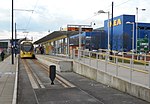Ashton-under-Lyne railway station
1846 establishments in EnglandBuildings and structures in Ashton-under-LyneDfT Category E stationsFormer Lancashire and Yorkshire Railway stationsNorthern franchise railway stations ... and 4 more
Pages with no open date in Infobox stationRailway stations in Great Britain opened in 1846Railway stations in TamesideUse British English from December 2017

Ashton-under-Lyne railway station serves the town of Ashton-under-Lyne, in Greater Manchester, England. It lies on the Huddersfield Line 6½ miles (10 km) east of Manchester Victoria and is operated by Northern Trains. The station is a short walk from Ashton-under-Lyne bus station and Ashton-under-Lyne tram stop which opened in 2013, and is served by Manchester Metrolink trams to Droylsden, Manchester, and Eccles.
Excerpt from the Wikipedia article Ashton-under-Lyne railway station (License: CC BY-SA 3.0, Authors, Images).Ashton-under-Lyne railway station
Turner Lane, Tameside Hurst
Geographical coordinates (GPS) Address Nearby Places Show on map
Geographical coordinates (GPS)
| Latitude | Longitude |
|---|---|
| N 53.4913 ° | E -2.0943 ° |
Address
Aston-under-Lyne
Turner Lane
OL6 6DE Tameside, Hurst
England, United Kingdom
Open on Google Maps








